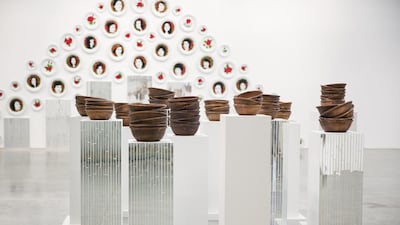Standing in the middle of Jamm Art Gallery in Dubai’s Al Quoz district is a series of white plinths, covered in mirror mosaics. On them are stacks of empty bowls encased in copper plating.
They are symbols of war, hope, and a symbol of Iran.
The artwork, Untitled 2014, is part of a group show from husband and wife team Yashar Samimi Mofakham and Tarlan Rafiee, Tehran-based artists who have created separate pieces for the show, but whose practice is very much interlinked.
The bowls symbolise the tradition of distributing a thick soup of noodles, rice and beans called osh to friends and neighbours whenever a family member who is a soldier is leaving home to go for war.
“It is a gift for the whole community that people hope will bless the traveller on his journey and bring him back safely,” says Mofakham, who conceived the piece. “Of course the irony is that they very rarely did come home from war. I wanted to freeze the moment of hope, so I encased the empty bowls in copper.”
Intentionally, the bowls are also placed against the backdrop of Rafiee’s work – a series of hand-painted porcelain plates arranged in a pyramid shape on the wall.
Rafiee says she chose plates because they are delicate and therefore a fitting canvas for the portraits of well-known female singers from Iran, Turkey and the Arab world that she has painted upon them.
“I have painted them here and arranged them in such a fashion to make it like a holy place,” she says, “because as a 34-year-old Iranian woman who was born at the same time as the revolution, I have never seen a woman perform in my home country.”
These two pieces underline the theme of the whole show which, titled 30 Years, is a visual narrative of the lives of these two artists and also the tale of their country over the last three decades.
At the entrance, Mofakham has placed an installation of plastic tulips, also coated in a copper-plated epoxy resin. Tulips are an enduring symbol of the blood of young martyrs in Iran and were also used as a kind of propaganda to prolong the war and sentiments of it within the country.
Mofakham has arranged his tulips on shelves covered in the same mirror mosaic so as to create a kind of memorial to these lives lost.
He also bemoans the inappropriate symbol: “How is it possible that such a beautiful flower can grow from such an ugly war?”
Ancient battles are also played out on another wall in a large mural, based on the story of Sohrab and Rustum, in which the father accidentally killed his son in single combat.
Mofakham has taken an illustrative coffee-house painting and removed almost all of the details so that what is left is one sole cypress tree, an outline of a shape and one line of a tragic poem from Persian culture.
“We want to show people it was our war, it was our life in Iran, but could easily be someone else’s and that is why we use these symbols.”
Yashar Samimi Mofakham and Tarlan Rafiee: 30 Years runs until October 30 at Jamm Gallery, Dubai. For more information visit www.jamm-art.com
aseaman@thenational.ae

